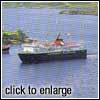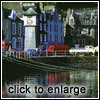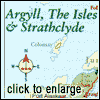|
The Isles
Slate Islands
There is an excellent, highly scenic excursion south
of town to the islands of Seil, Easdale and Luing, collectively known as the Slate
Islands as they once produced over 9 million slates annually in the mid nineteenth
century.
Follow the A816 to the B844 then cross via the Clachan
Bridge, known as the only bridge to cross the Atlantic.
The village of Ellanbeich is also locally known as
Easdale, which is the name for the island opposite. An unusual art gallery and visitor
centre exists in Ellanbeich run by C.J. Taylor who paints most of the exhibits himself.
A small ferry from Ellanbeich runs on demand to Easdale Island through the winter;
push the fog-horn button on the small wooden shed on the jetty. Otherwise, through
summer months it runs regularly.
Near the Easdale Jetty there is a folk museum which
focuses pictorially on the slate quarry industry that was once so prolific here.
The quarries, now full of sea water, can be dangerous cliffs so take care of small
children. The sea can be quite dramatic dashing against the cliffs with its blue-green
spray.
The small Cuan Ferry crossing the channel of the same
name from the southern tip of Seil Island reaches the island of Luing.
The Cuan Ferry operates regularly through the summer
and on demand at other times. The island is quite scenic and not very commercialised.
The population here was shifted during the Clearances to make way for cattle, which
are still known for their quality beef.
Mull
 Back in Oban, the ferry for Mull leaves Oban six times a day
during the summer and takes 50 minutes. If you intend to take your car it is best
to make a vehicle reservation. Mull is the second largest of the Inner Hebridean
islands. "Isle of the Cool High Bends" is the translation from Gaelic. Back in Oban, the ferry for Mull leaves Oban six times a day
during the summer and takes 50 minutes. If you intend to take your car it is best
to make a vehicle reservation. Mull is the second largest of the Inner Hebridean
islands. "Isle of the Cool High Bends" is the translation from Gaelic.
Mull suffered similar deprivations to other Highland
areas during the Clearances and potato famine which led to a rapid decline in its
mainly crofting and fishing population. In recent years this trend has been reversed
with a noticeable influx of settlers from the south. Its terrain consists of a mix
of mountains, moorland, forest and craggy cliffs with the occasional stretch of white,
sparking beach.
Duart Castle is seen from the ferry during the approach
to the harbour, set on its outstanding location of Lady's Rock and accessible just
south of the small village of Craignure. Built as a simple fortification by the Lord
of the Isles in the thirteenth century, it was transformed through the centuries
into a classical residence of the Highland chieftain.
The road south and west to Fionnphort (pronounced
'Finnafort'), the A849, is uneventful through forestry land and moors apart from
the last stretch along Loch Scridian with impressive views of Ben More to the north.
Fionnphort is little more than a parking place for
those that take the 'passenger only' ferry service the 1 mile (2km) across the Sound
of Iona.
There is a prohibition on driving on the roads on
Iona. The only visitor's vehicles allowed are those specifically adapted for a disabled
person and not just a registered disabled vehicle. For an application you must phone
Strathclyde Roads Department in Oban (Tel 01631 62125) well in advance of your trip.
A wheel-chair, if required, is available at the Cal Mac ticket office in Fionnphort.
On the island side it is an ideal half-mile walk to the abbey.
Iona was the site chosen by St Columba to establish
his Celtic church in AD563. The Irish saint landed here and began converting the
heathen Picts to Christianity throughout Scotland. Through the following centuries
no less than forty-eight Scottish kings were buried here, as was John Smith, the
leader of the British Labour Party, following his sudden death in 1994.
The narrow road leads past the thirteenth century
Nunnery of St Mary constructed of lovely pink granite. The Presbyterian Socialist,
George Macleod, who established a new community on the island to rebuild and revitalise
the holy site, constructed the present abbey in 1938. For the many Christians who
come here now there is special significance. Some, however, feel the essence of the
place is missing, driven away by the slightly commercial enterprise they encounter.
For the more eclectic, the beautiful natural bays
and pure white sands of the west side of Iona hold more spiritual substance, most
notably 'The Bay at the Back of the Ocean' or 'Camus Cul an Taibh' in Gaelic. The
island is only 3 miles by 1 mile (5km by 2km) and worth exploring further.
Returning to Mull and the north B8035 route to Tobermory
following the west coast, Ben More, the islands highest peak at 3,196ft (966m), dominates
the panorama.
The village of Calgary on the north shore with its
lovely white beaches breaking the craggy coastline gave its name to the Canadian
city.
 The island of Staffa is 6 miles (10km) north-east of Iona
and a short boat ride from this western side of Mull, a small and uninhabited rock
famous for its basaltic formations and unusual caves. Fingal's Cave is the best known,
made famous by Mendelsshon in his Hebrides overture. To reach Staffa there are boats
leaving from Dervaig on Mull. The island of Staffa is 6 miles (10km) north-east of Iona
and a short boat ride from this western side of Mull, a small and uninhabited rock
famous for its basaltic formations and unusual caves. Fingal's Cave is the best known,
made famous by Mendelsshon in his Hebrides overture. To reach Staffa there are boats
leaving from Dervaig on Mull.
To reach the town of Tobermory it is possible, as
well as taking this scenic drive, to catch the ferry from Oban, which takes nearly
2 hours. This is the capital of Mull and its most scenic inhabited corner. Though
not of great consequence, Tobermory was a fishing village, its harbour being one
of the most sheltered in the Hebrides. Today most of the activity around the harbour
is of leisure yachts and cruisers, coming in to take supplies and make use of the
port's fine hostelries.
In 1588 following the destruction of the Spanish Armada,
a galleon possibly named the Florencia pulled into Tobermory Bay and there are now
many stories surrounding the event. One goes that Spanish soldiers were lent to MacLean
of Duart to help him attack Mingarrie Castle, carrying on a fewd with Maclean of
Coll. It became known that the Armada's treasure of gold coins was on board and,
while the ship's company was depleted, a raider stole aboard and fired the ship's
magazine. With 350 men still on board she blew up in the Bay near Calve Island, some
80 yards off shore and sank to 11 fathoms.
Many attempts have been made to rescue the treasure
but only a few pieces have been released from the muddy depths. The Mull and Iona
Folklore Museum on the front tells more about the galleon. Treasure seekers from
around the world still speculate, but the wreck is protected from divers.
Tobermory is an excellent place to enjoy a traditional
'ceilidh' if you can stand the pace. The Mishnish pub is one of the most lively.
The whirling and 'heuching' goes on until closing time, following which there might
be similar fun found in the village hall until the early hours. Explore the Upper
Town of Tobermory, the more residential and elegant part from which there are superb
views over the Sound of Mull.
Coll and Tiree
Other islands served by the ferries from Oban are
Coll and Tiree. The island of Tiree is known for holding championship windsurfing
events as it has become one of the world's top wave sailing venues. There is also
a lovely golf course with spectacular views over the Atlantic - next stop Canada.
Loch Awe and Loch Fyne
Returning to the mainland, the A85 route east passes
one of Scotland's longest lochs. Kilchurn Castle lies at the north end of the 23
mile long Loch Awe. A stronghold of the Campbells of Glenorchy for 300 years, it
now stands broken but yet magnificent with the ranges of Ben Lui behind it and almost
surrounded by the shallow waters of the loch.
Inverary
 Just beyond Loch Awe there are signs for Inverary. Inverary
would be a pleasant place if it was not so popular. Inverary is Campbell country
on the north-west side of Loch Fyne on the A83. On the harbour is Inverary Jail with
its Court Room, squalid cells and life sized models depicting the lot of the in-mates
of the time, mending nets, feeding children or being tried for insurance fraud. This
establishment functioned until the 1930s. Just beyond Loch Awe there are signs for Inverary. Inverary
would be a pleasant place if it was not so popular. Inverary is Campbell country
on the north-west side of Loch Fyne on the A83. On the harbour is Inverary Jail with
its Court Room, squalid cells and life sized models depicting the lot of the in-mates
of the time, mending nets, feeding children or being tried for insurance fraud. This
establishment functioned until the 1930s.
There are many pieces of notable architecture in and
around the village including the two bridges, the Garron Bridge at the head of the
loch and the Garden Bridge nearby.
Set apart from the town with its mock Gothic towers
peaking above the trees, Inverary Castle is still the seat of the Duke of Argyll.
The most impressive display inside is the Arms Room where eighteenth century weaponry
of every type reaches for the ceilings. This was supplied to the Campbells to help
suppress the Jacobite insurrection.
Inverary was an important training centre during the
World War II and a Combined Operations Museum found in the grounds illustrates this
period of the castle and community's history.
A woodland walk to the summit of Duniquaich gives
a wide panorama of the castle, town and loch.
Following the shores of Loch Fyne on the A83, the
Argyl Wildlife Park is signposted with its wild cats, wild boar and tame roe deer.
A little further on, the old West Highland township
of Auchindrain appears. The twenty or so thatched cottages have been well restored
to present Highland life of the past before the time of Clearances and planned villages
such as Inverary. All the old utensils, farm gear and domestic furnishings are gathered
in the buildings. A visitor's centre and tea room completes the encounter.
|



